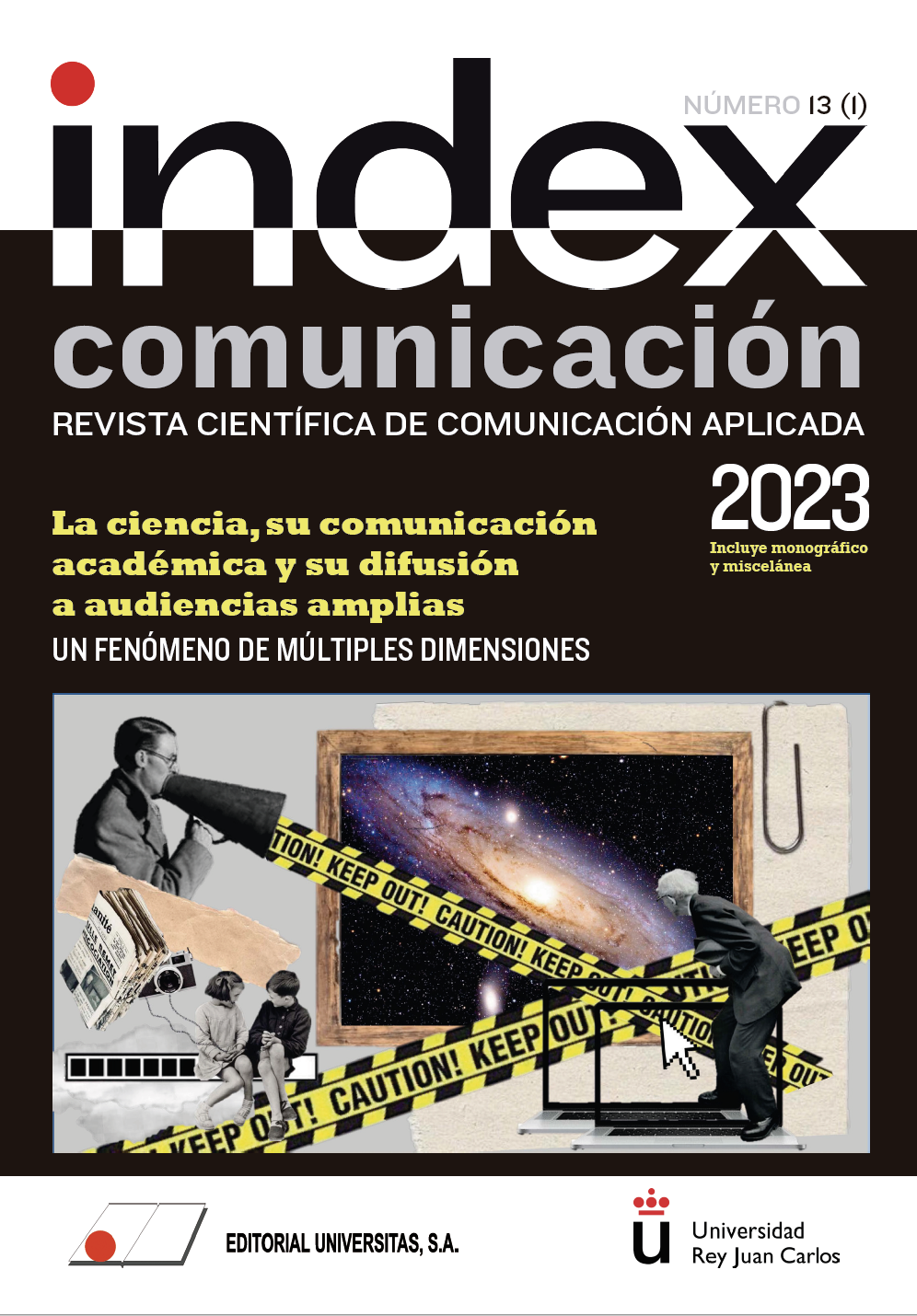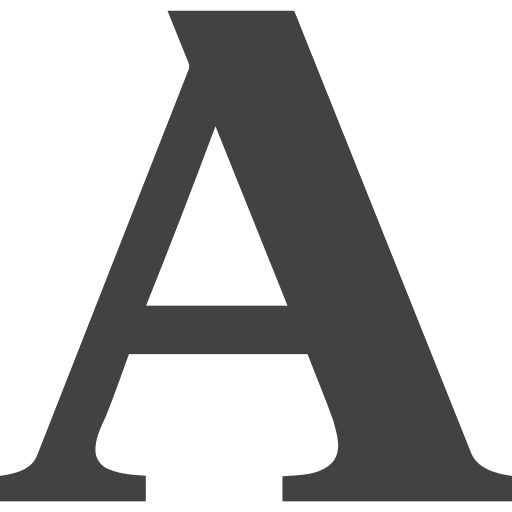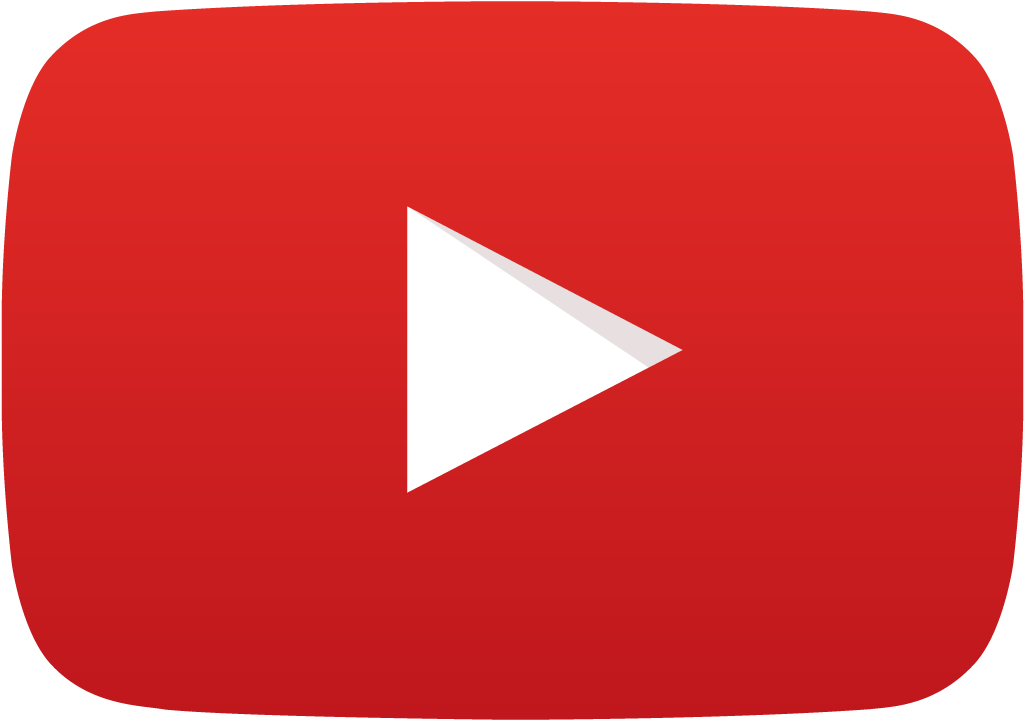Las redes sociales como vehículo del periodismo científico: 'Scoping Review'
DOI:
https://doi.org/10.33732/ixc/13/01LasredPalabras clave:
desinformación, divulgación científica, periodismo científico, redes sociales, scoping reviewResumen
La pandemia por COVID-19 ha puesto de manifiesto la importancia del periodismo científico y el rol que desempeña a la hora de transmitir una información rigurosa, contrastada y de calidad a la sociedad. En este contexto, tanto a nivel profesional como académico, se pone el foco en la disciplina y, de forma creciente, en el papel de las redes sociales como vehículo para potenciar los contenidos de divulgación científica. El presente trabajo analiza, por medio de la técnica de scoping review, los artículos publicados sobre periodismo científico y redes sociales en el último lustro (2017 y 2021) con objeto de identificar tópicos y tendencias de investigación, preocupaciones y desafíos. El estudio revela la influencia que las redes sociales están teniendo en el periodismo científico actual, destacando su rol como canal de difusión e interacción con las audiencias y engagement con nuevos públicos. Se advierte, además, del reto que supone para los profesionales mejorar su desempeño para lograr una comunicación efectiva a través de los nuevos canales y generar contenidos cada vez más visuales e interactivos.
Métricas
Citas
ARCILLA CALDERÓN, C.; OLLER ALONSO, M. y BLANCO HERRERO, D. (2021). Digitalization of Ibero-American journalism and its effect on the journalist’s relationship with the audience. Comparative study of Argentina, Brazil, Chile, Colombia, Ecuador, El Salvador, Spain, Mexico and Portugal. Journal of Iberian and Latin American Research, 1-17. https://https://doi.org/10.1080/13260219.2020.1909831
BAKANOV, R.P.; EGOROVA, L.; MAYOROV, V.; TUMANOV, D. y TYABINA, D. (2018). Popularization of Science in the Russian Mass Media: Challenges of Multimedia Formats. Journal of History Culture and Art Research, 7(4), 381-386. https://doi.org/10.7596/taksad.v7i4.1860
BARASHKOVA, A.L.; VOROB’EV, I.V.; SHAVAEV, A.A. y ZAPOLSKAYA, A.N. (2019). New Methods of Science Popularization in the Social Media: Modern Trends and Communications. Proceedings of the 2019 IEEE International Conference Quality Management, Transport and Information Security, Information Technologies IT and QM and IS 2019, 463-465. https://doi.org/10.1109/ITQMIS.2019.8928354
BARCHAS-LICHTENSTEIN, J.; FRASER, J.; PARSON, P.; NORLANDER, R.J.; GRIFFIN, J.; AKPAN, N.; DAUB, T.; MARDER, J.; RAINE, C.; ROBERTS, S.J.; BOULTER, M.; CAREY, T.; DENNIS, V.; HENDRY, E.; HUGO, K.; KHAN, S.; KOCAK, I.; SANTHANAM, L.; SHIVNI, R. … WAGNER, A. (2019). Negotiating Genre and New Media for STEM News. Journalism Practice, 14(6), 643-663. https://doi.org/10.1080/17512786.2019.1631711
BOY, B.; BUCHER, H.J. y CHRIST, K. (2020). Audiovisual Science Communication on TV and YouTube. How Recipients Understand and Evaluate Science Videos. Frontiers in Communication, 5, 1-18. https://doi.org/10.3389/fcomm.2020.608620
BÜCHI, M. (2017). Microblogging as an extension of science reporting. Public Understanding of Science, 26(8), 953-968. https://doi.org/10.1177/0963662516657794
BURCH, E. (2021). A Sea Change for Climate Refugees in the South Pacific: How Social Media —Not Journalism— Tells Their Real Story. Environmental Communication, 15(2), 250-263. https://doi.org/10.1080/17524032.2020.1821742
CALVO, L.M. y UFARTE-RUIZ, M.J. (2021). The academic training of iberoamerican journalists to communicate science and its relationship with investment in R&D. Revista Prisma Social, 32, 321-343. https://bit.ly/3AQG0c6
CASTELLS-FOS, L.; PONT-SORRIBES, C. y CODINA, L. (2022). La sostenibilidad de los medios a través de los conceptos de engagement y relevancia: scoping review. Doxa Comunicación, 35, 19-38. https://doi.org/10.31921/doxacom.n35a1627
CASTILLO RAMÍREZ, I. y ALBERICH PASCUAL, J. (2017). Analysis of content diffusion strategies and social networking activity in popular science magazines: factors of interaction, visibility and impact. Estudios sobre el Mensaje Periodístico, 23(2), 1045-1056. https://doi.org/10.5209/ESMP.58031
CHOMÓN-SERNA, J.M. y BUSTO-SALINAS, L. (2018). Science and transmedia: A binomial for scientific dissemination. The Atapuerca case. El Profesional de la Información, 27(4), 938-946. https://doi.org/10.3145/epi.2018.jul.22
CLAASSEN, G. (2021). The viral spreading of pseudoscientific and quackery health messages on twitter-finding a communication vaccine. Current Allergy and Clinical Immunology, 34(1), 18-22.
https://doi.org/10.520/ejc-caci-v34-n1-a4
CODINA, L. (2022). El modelo IMRyD de artículos científicos: ¿qué es y cómo se puede aplicar en humanidades y ciencias sociales? Hipertext.net, 24, 1-8. https://doi.org/10.31009/hipertext.net.2022.i24.01
COSTA-SÁNCHEZ, C.; RODRÍGUEZ-VÁZQUEZ, A.I. y LÓPEZ-GARCÍA, X. (2015). From transmedia to repurposing journalism. Elpais.com press coverage about case of ebola in Spain. El Profesional de la Información, 24(3), 282-290. https://doi.org/10.3145/epi.2015.may.08
COSTA-SÁNCHEZ, C. y TÚÑEZ-LÓPEZ, M. (2019). Audiovisual Content in Social Media. A Comparative Analysis of Facebook and Youtube. Fonseca, Journal of Communication, 19, 223-236. https://doi.org/10.14201/fjc201919223236
DAVIES, S.R., FRANKS, S.; ROCHE, J.; SCHMIDT, A.L.; WELLS, R. y ZOLLO, F. (2021). The landscape of European science communication. JCOM, 20(3), 1-19. https://doi.org/10.22323/2.20030201
DE DOBBELAER, R.; VAN LEUVEN, S. y RAEYMAECKERS, K. (2018). The Human Face of Health News: A Multi-Method Analysis of Sourcing Practices in Health-Related News in Belgian Magazines. Health Communication, 33(5), 611-619. https://doi.org/10.1080/10410236.2017.1287237
DENIA, E. (2021). Twitter as a research tool in science communication. Revista Mediterránea de Comunicación, 12(1), 289-301. https://doi.org/10.14198/MEDCOM000006
DIVIU-MIÑARRO, C. y CORTIÑAS-ROVIRA, S. (2020). Cómo comunicar una pandemia a la sociedad: la visión de los profesionales. Estudio de caso de la Covid-19 en el sur de Europa. El Profesional de la Información, 29(5), 1-15. https://doi.org/10.3145/epi.2020.sep.12
DJERF-PIERRE, M.; LINDGREN, M. y BUDINSKI, M.A. (2019). The role of journalism on youtube: Audience engagement with “superbug” reporting. Media and Communication, 7(1), 235-247. https://doi.org/10.17645/mac.v7i1.1758
FONTAINE, G.; LAVALLÉE, A.; MAHEU-CADOTTE, M.A.; BOUIX-PICASSO, J. y BOURBONNAIS, A. (2018). Health science communication strategies used by researchers with the public in the digital and social media ecosystem: A systematic scoping review protocol. BMJ Open, 8(1), 1-6. https://doi.org/10.1136/bmjopen-2017-019833
GALLAGHER, J.R. (2019). Monitoring and managing online comments in science journalism. En G. AGBOKA & N. MATVEEVA (Eds.), Citizenship and Advocacy in Technical Communication (pp. 137-152). Routledge. https://doi.org/10.4324/9780203711422-7
GARCÍA-MARÍN, D. y MERINO-ORTEGO, M. (2022). Desinformación anticientífica sobre la COVID-19 difundida en Twitter en Hispanoamérica. Cuadernos.info, 52, 24-46. https://doi.org/10.7764/cdi.52.42795
GARCÍA RIVERO, A.; MARTÍNEZ ESTRELLA, E.C. y BONALES DAIMIEL, G. (2022). TikTok y Twitch: new media and formulas to impact the Generation Z. Revista ICONO 14. Revista científica de Comunicación y Tecnologías emergentes, 20(1), 1-29. https://doi.org/10.7195/ri14.v20i1.1770
GILLAM, C. (2020). Finding and following the facts in an era of fake news. En D. SACHSMAN & J. MYER VALENTI (Eds.), Routledge Handbook of Environmental Journalism (pp. 83-94). Routledge. https://bit.ly/3bECgAh
GONZÁLEZ CLAVERO, M.V. y RODRÍGUEZ BAZÁN, G. (2021). Gestión informativa de la infodemia en medios digitales: experiencia de las agencias de noticias. Revista Panamericana de Salud Pública, 45(25), 1-5. https://doi.org/10.26633/rpsp.2021.25
GRANT, M.J. y BOOTH, A. (2009). A typology of reviews: an analysis of 14 review types and associated methodologies. Health Information and Libraries Journal, 26(2), 91-108. https://doi.org/10.1111/j.1471-1842.2009.00848.x
GUENTHER, L. y JOUBERT, M. (2021). Novel interfaces in science communication: Comparing journalistic and social media uptake of articles published by The Conversation Africa. Public Understanding of Science, 30(8), 1041-1057. https://doi.org/10.1177/09636625211019312
GUENTHER, L.; RUHRMANN, G.; ZAREMBA, M.C. y WEIGELT, N. (2021). The newsworthiness of the “March for Science” in Germany: comparing news factors in journalistic media and on Twitter. JCOM, 20(2), 1-27. https://doi.org/10.22323/2.20020203
HARMATIY, O. (2021). Science Coverage: What Does the Audience Want and Really Need? Exploring Media Consumption in Ukraine. Journal of Creative Communications, 16(1), 97-112. https://doi.org/10.1177/0973258620981799
HAYES, C.; STOTT, K.; LAMB, K.J. y HURST, G.A. (2020). “Making Every Second Count”: Utilizing TikTok and Systems Thinking to Facilitate Scientific Public Engagement and Contextualization of Chemistry at Home. Journal of Chemical Education, 97(10), 3858-3866. https://doi.org/10.1021/acs.jchemed.0c00511
HERRERO-DIZ, P.; PÉREZ-ESCOLAR, M. y VARONA ARAMBURU, D. (2022). Fact-checking skills: a proposal for Communication studies. Revista de Comunicación, 21(1), 231-249. https://doi.org/10.26441/rc21.1-2022-a12
HOPKE, J. y HESTRES, L. (2017). The Paris climate talks (COP21) in visual social media. #SMSociety17: Proceedings of the 8th International Conference on Social Media & Society, 1-5. https://doi.org/10.1145/3097286.3097328
HÖTTECKE, D. (2020). The mediation of science in the age of social media. Journal and Proceedings of the Royal Society of New South Wales, 152(3), 307-319. https://bit.ly/3Qr5y49
HOWELL, E. y BROSSARD, D. (2019). Science engagement and social media: Communicating across interests, goals, and platforms. En T. NEWMANN (Ed.), Theory and Best Practices in Science Communication Training (pp. 57-70). Routledge. https://bit.ly/3p8uEsR
JARREAU, P. y PORTER, L. (2018). Science in the Social Media Age: Profiles of Science Blog Readers. Journalism and Mass Communication Quarterly, 95(1), 142-168. https://doi.org/10.1177/1077699016685558
KITSA, M. (2021). Media as a source of popular science information during COVID-19 pandemic. International Journal of Media and Information Literacy, 6(1), 119-128. https://doi.org/10.13187/IJMIL.2021.1.119
LA, V.-P.; PHAM, T.-H.; HO, M.-T.; NGUYEN, M.-H.; NGUYEN, K.-L.P.; VUONG, T.-T.; NGUYEN, H.-K.T.; TRAN, T.; KHUC, Q.; HO, M.-T. y VUONG, Q.-H. (2020). Policy Response, Social Media and Science Journalism for the Sustainability of the Public Health System Amid the COVID-19 Outbreak: The Vietnam Lessons. Sustainability, 12, 1-27. https://doi.org/10.3390/su12072931
LEE, N. M.; VANDYKE, M.S. y CUMMINS, R.G. (2018). A Missed Opportunity?: NOAA’s Use of Social Media to Communicate Climate Science. Environmental Communication, 12(2), 274-283. https://doi.org/10.1080/17524032.2016.1269825
LEÓN, B.; MARTÍNEZ-COSTA, M.-P.; SALAVERRÍA, R. y LÓPEZ-GOÑI, I. (2022). Health and science-related disinformation on COVID-19: A content analysis of hoaxes identified by fact-checkers in Spain. Plos One, 17(4), 3-18. https://doi.org/10.1371/journal.pone.0265995
LI, N.; BROSSARD, D.; SCHEUFELE, D.A.; WILSON, P.H. y ROSE, K.M. (2018). Communicating data: interactive infographics, scientific data and credibility. Journal of Science Communication, 17(2), 1-20. https://doi.org/10.22323/2.17020206
LO, Y.Y.; HUANG, C.J. y PETERS, H.P. (2019). Do organizational interests interfere with public communication of science? An explorative study of public relations of scientific organizations in Taiwan. East Asian Science, Technology and Society, 13, 557-574.
https://doi.org/10.1215/18752160-8005617
LOBATO, R.; VELANDIA-MORALES, A.; SÁNCHEZ-RODRÍGUEZ, Á.; MONTOYA-LOZANO, M. y GARCÍA-SÁNCHEZ, E. (2021). Fact-checking on twitter: An analysis of the hashtag #stopbulos. Interamerican Journal of Psychology, 55(2), 1-23. https://doi.org/10.30849/ripijp.v55i2.1371
LÓPEZ-GARCÍA, X.; COSTA-SÁNCHEZ, C. y VIZOSO, Á. (2021). Journalistic fact-checking of information in pandemic: Stakeholders, hoaxes, and strategies to fight disinformation during the covid-19 crisis in Spain. International Journal of Environmental Research and Public Health, 18(1227), 1-15. https://doi.org/10.3390/ijerph18031227
LÓPEZ DUQUE, D. y TEJEDOR, S. (2020). The Dissemination of science news in the main generalist cybermedia of Spain: El País, La Vanguardia, El Periódico and El Mundo. Perspectivas em Ciência da Informação, 25(1), 131-159. https://doi.org/10.1590/1981-5344/4060
LOPEZOSA, C.; CODINA, L.; FERNÁNDEZ-PLANELLS, A. y FREIXA, P. (2021). Journalistic innovation: How new formats of digital journalism are perceived in the academic literature. Journalism, 1-17. https://doi.org/10.1177/14648849211033434
LUKANDA, I.N. (2019). Implications of Media-Scientists’ Relationship on Crop Biotechnology Debate in Uganda. En Y. BAMUTAZE, S. KYAMANYWA, G. NABANOGA, B. RAM SINGH, & R. LAL (Eds.), Agriculture and Ecosystem Resilience in Sub Saharan Africa: Livelihood Pathways Under Changing Climate (pp. 633-652). Springer. https://bit.ly/3QKGiX1
LUTZ, S.R.; POPP, A.; VAN EMMERIK, T.; GLEESON, T.; KALAUGHER, L.; MÖBIUS, K.; MUDDE, T.; WALTON, B.; HUT, R.; SAVENIJE, H.; SLATER, L.J.; SOLCEROVA, A.; STOOF, C.R. y ZINK, M. (2018). HESS Opinions: Science in today’s media landscape-Challenges and lessons from hydrologists and journalists. Hydrology and Earth System Sciences, 22, 3589-3599. https://doi.org/10.5194/hess-22-3589-2018
MAIDEN, N.; ZACHOS, K.; FRANKS, S.; WELLS, R. y STALLARD, S. (2020). Designing Digital Content to Support Science Journalism. NordiCHI ’20: Proceedings of the 11th Nordic Conference on Human-Computer Interaction: Shaping Experiences, Shaping Society, 1-13. https://doi.org/10.1145/3419249.3420124
MANNINO, I.; BELL, L.; COSTA, E.; DI ROSA, M.; FORNETTI, A.; FRANKS, S.; IASILLO, C.; MAIDEN, N.; OLESK, A.; PASOTTI, J.; RENSER, B.; ROCHE, J.; SCHOFIELD, B.; VILLA, R. y ZOLLO, F. (2021). Supporting quality in science communication: insights from the QUEST project. JCOM, 20(3), 1-22. https://doi.org/10.22323/2.20030207
MARTIN-NEIRA, J.-I.; TRILLO-DOMÍNGUEZ, M. y OLVERA-LOBO, M.-D. (2022). The dissemination of scientific news in the Chilean press: Analysis of digital and printed publications on coronavirus. En M. ÁLVAREZ-CHÁVEZ, G. RODRÍGUEZ-GARAY, & S. HUSTED (Eds.), Communication and plurality in a divergent context (pp. 800-829). Dykinson S.L. https://bit.ly/3OEVQtI
MATASSI, M. y BOCZKOWSKI, P.J. (2020). Redes sociales en Iberoamérica. El Profesional de la Información, 29(1), 1-21. https://doi.org/https://doi.org/10.3145/epi.2020.ene.04
MELLADO, C. (2020). Journalistic Role Performance and the News. En C. MELLADO (Ed.), Beyond Journalistic Norms Role Performance and News in Comparative Perspective (pp. 3-21). Routledge. https://bit.ly/3R0qLCh
MENA YOUNG, M. (2022). The audiovisual communication of science in social networks in Costa Rica. Cuadernos.info, 52, 91-112. https://doi.org/10.7764/cdi.52.42405
MESQUITA, L. y FERNANDES, K. (2021). The New Praxeology of Digital Journalism in Latin America: Media Organizations Learn How to Walk by Running. En R. SALAVERRÍA & M. DE-LIMA-SANTOS (Eds.), Journalism, Data and Technology in Latin America. Palgrave Studies in Journalism and the Global South (pp. 23-53). Palgrave Macmillan, Cham. https://doi.org/10.1007/978-3-030-65860-1
MOLINA-CAÑABATE, J.-P. y MAGALLÓN-ROSA, R. (2020). Misinformation and scientific journalism. The case of Maldita Ciencia. Revista Mediterránea de Comunicación, 11, 11-20. https://doi.org/10.14198/MEDCOM2020.11.2.4
MUELLER-HERBST, J.M.; XENOS, M.A., SCHEUFELE, D.A. y BROSSARD, D. (2020). Saw It on Facebook: The Role of Social Media in Facilitating Science Issue Awareness. Social Media and Society, 6(2), 1-14. https://doi.org/10.1177/2056305120930412
NEGREIRA-REY, M.-C.; VÁZQUEZ-HERRERO, J. y LÓPEZ-GARCÍA, X. (2022). Blurring Boundaries Between Journalists and Tiktokers: Journalistic Role Performance on TikTok. Media and Communication, 10(1), 146-156. https://doi.org/10.17645/mac.v10i1.4699
NOWAK, G.J. y CACCIATORE, M.A. (2020). Media Science and Practice. En P. BAHRI (Ed.), Communicating about Risks and Safe Use of Medicines: Real Life and Applied Research (pp. 285-305). Springer.
https://doi.org/10.1007/978-981-15-3013-5
OLVERA-LOBO, M.D. y LÓPEZ-PÉREZ, L. (2015). Science journalism: the homogenization of information from paper to internet. JCOM, 14(03), 1-12. https://bit.ly/3uTfryu
PAN, Y.; OPGENHAFFEN, M. y VAN GORP, B. (2019). The Use of Social Media by Chinese Climate Journalists: A Case Study of COP21. Journalism Practice, 1-20. https://doi.org/10.1080/17512786.2019.1667260
PÉREZ-ESCODA, A.; BARÓN-DULCE, G. y RUBIO-ROMERO, J. (2021). Mapping media consumption among youngest: Social networks, fake news and trustworthy in pandemic times. Index.comunicacion, 11(2), 187-208. https://doi.org/10.33732/ixc/11/02Mapeod
QUANDT, T. y WAHL-JORGENSEN, K. (2021). The Coronavirus Pandemic as a Critical Moment for Digital Journalism: Introduction to Special Issue: Covering Covid-19: The Coronavirus Pandemic as a Critical Moment for Digital Journalism. Digital Journalism, 9(9), 1199-1207. https://doi.org/10.1080/21670811.2021.1996253
QUIÑÓNEZ-GÓMEZ, H. y SÁNCHEZ-COLMENARES, M. (2017). Use of Twitter in Science Journalism. Case: El Nacional and El Universal in Venezuela (September-October 2014). Estudios Sobre el Mensaje Periodístico, 23(1), 553-568. https://doi.org/10.5209/ESMP.55613
RAMÍREZ ALMANSA, I. (2021). German-Spanish Contrastive Analysis for the Translation of Science Journalism: Science Popularization in News on Coronavirus. Mutatis Mutandis, 14(1), 240-265. https://doi.org/10.17533/udea.mut.v14n1a10
SAAVEDRA-LLAMAS, M.; HERRERO-DE-LA-FUENTE, M.; RODRÍGUEZ-FERNÁNDEZ, L. y JIMÉNEZ-NARROS, C. (2019). Información de salud: fuentes periodísticas y desafíos profesionales. El Profesional de la Información, 28(2), 1-9. https://doi.org/10.3145/epi.2019.mar.08
SALAVERRÍA, R. (2019). Digital journalism: 25 years of research. Review article. El Profesional de la Información, 28(1). https://doi.org/10.3145/epi.2019.ene.01
SCHÄFER, M.S. (2017). How Changing Media Structures Are Affecting Science News Coverage. En K.H. JAMIESON, D. KAHAN, & D.A. SCHEUFELE (Eds.), The Oxford Handbook of the Science of Science Communication (pp. 50-59). Oxford University Press. https://doi.org/10.1093/oxfordhb/9780190497620.001.0001
SCHÄFER, M.S. y PAINTER, J. (2021). Climate journalism in a changing media ecosystem: Assessing the production of climate change-related news around the world. Wiley Interdisciplinary Reviews: Climate Change, 12, 1-20. https://doi.org/10.1002/wcc.675
SCHARL, A.; HERRING, D.; RAFELSBERGER, W.; HUBMANN-HAIDVOGEL, A.; KAMOLOV, R.; FISCHL, D.; FÖLS, M. y WEICHSELBRAUN, A. (2017). Semantic Systems and Visual Tools to Support Environmental Communication. IEEE Systems Journal, 11(2), 762-771. https://doi.org/10.1109/JSYST.2015.2466439
SEGADO-BOJ, F.; CHAPARRO-DOMÍNGUEZ, M.Á. y DÍAZ-DEL CAMPO, J. (2018). Información científica en Argentina, España y México: fuentes, recursos multimedia y participación de los lectores en los diarios online. Estudios sobre el Mensaje Periodístico, 24(1), 397-412. https://doi.org/10.5209/ESMP.59957
SIDORENKO-BAUTISTA, P.; ALONSO-LÓPEZ, N. y GIACOMELLI, F. (2021). Fact-checking in TikTok. Communication and narrative forms to combat misinformation. Revista Latina de Comunicación Social, 79, 87-113. https://doi.org/10.4185/RLCS-2021-1522
SWART, J.; PETERS, C. y BROERSMA, M. (2018). Shedding light on the dark social: The connective role of news and journalism in social media communities. New Media and Society, 20(11), 4329-4345. https://doi.org/10.1177/1461444818772063
TADDICKEN, M. y KRÄMER, N. (2021). Public online engagement with science information: on the road to a theoretical framework and a future research agenda. JCOM, 20(3), 1-18. https://doi.org/10.22323/2.20030205
TEJEDOR CALVO, S.; PORTALÉS-OLIVA, M. y PUEYO VILLA, S. (2018). Web 2.0 y tratamiento informativo en las principales revistas españolas de divulgación científica y de la pseudociencia. Revista Latina de Comunicación Social, 73, 293-316. https://doi.org/10.4185/RLCS-2018-1256
TORRES, A.; KELLEY, C.; KELLEY, S.; PIÑA, G.; GARCIA-BAZA, I. y GRIFFITH, I. (2021). An Analysis of Digital Media Data to Understand Parents’ Concerns During the COVID-19 Pandemic to Enhance Effective Science Communication. Journal of Creative Communications, 16(2), 1-22. https://doi.org/10.1177/09732586211000281
TRILLO-DOMÍNGUEZ, M. y ALBERICH-PASCUAL, J. (2020). Analysis and typification of emerging formats in Spanish cyberjournalism: From multimedia adaptation to transmedia disruption. Estudios Sobre el Mensaje Periodístico, 26(1), 367-375. https://doi.org/10.5209/esmp.67317
VAN DIJCK, J. y ALINEAD, D. (2020). Social Media and Trust in Scientific Expertise: Debating the Covid-19 Pandemic in The Netherlands. Social Media and Society, 6(4), 1-11. https://doi.org/10.1177/2056305120981057
VERNAL-VILICIC, T.P. y VALDERRAMA ZENTENO, L.B. (2022). Comunicación pública de la ciencia y la tecnología en Iberoamérica. Cuadernos.info, 52, 1-3. https://doi.org/10.7764/cdi.52.50593 Editorial
VERNAL-VILICIC, T.P.; VALDERRAMA ZENTENO, L.B.; CONTRERAS-OVALLE, J. y ARRIOLA, T. (2019). Perception of training and specialization of scientific journalism in Chile. Cuadernos.info, 45, 213-226. https://doi.org/10.7764/cdi.45.1717
WEITKAMP, E.; MILANI, E.; RIDGWAY, A. y WILKINSON, C. (2021). Exploring the digital media ecology: insights from a study of healthy diets and climate change communication on digital and social media. JCOM, 20(3), 1-22. https://doi.org/10.22323/2.20030202
ZHANG, X.; BIE, B. y BILLINGS, A.C. (2017). Newspaper ebola articles differ from twitter updates. Newspaper Research Journal, 38(4), 497-511. https://doi.org/10.1177/0739532917739883
Publicado
Cómo citar
Número
Sección
Licencia
Derechos de autor 2022 Juan Ignacio Martin Neira, Magdalena Trillo-Domínguez, María-Dolores Olvera-Lobo

Esta obra está bajo una licencia internacional Creative Commons Atribución-NoComercial 4.0.
Los autores que publican en esta revista están de acuerdo con los siguientes términos:
Los autores conservan los derechos de autor y garantizan a la revista el derecho de ser la primera publicación del trabajo al igual que licenciado bajo una Licencia Creative Commons Atribución-NoComercial 4.0 Internacional que permite a otros compartir el trabajo con un reconocimiento de la autoría del trabajo y la publicación inicial en esta revista, sin finalidad comercial.
Los autores pueden establecer por separado acuerdos adicionales para la distribución no exclusiva de la versión de la obra publicada en la revista (por ejemplo, situarlo en un repositorio institucional o publicarlo en un libro), con un reconocimiento de su publicación inicial en esta revista.
Se permite y se anima a los autores a difundir sus trabajos electrónicamente (por ejemplo, en repositorios institucionales o en su propio sitio web) antes y durante el proceso de envío, ya que puede dar lugar a intercambios productivos, así como a una citación más temprana y mayor de los trabajos publicados (Véase The Effect of Open Access) (en inglés).















